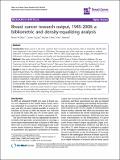| dc.contributor.author | Glynn, Ronan W. | en |
| dc.contributor.author | Kerin, Michael J. | en |
| dc.date.accessioned | 2011-05-25T12:13:01Z | en |
| dc.date.available | 2011-05-25T12:13:01Z | en |
| dc.date.issued | 2010-12 | en |
| dc.identifier.citation | Glynn, R., Scutaru, C., Kerin, M., & Sweeney, K. (2010) Breast cancer research output, 1945-2008: a bibliometric and density-equalizing analysis. Breast Cancer Research, 12(6), R108. | en |
| dc.identifier.uri | http://hdl.handle.net/10379/1934 | en |
| dc.description.abstract | Introduction: Breast cancer is the most common form of cancer among women, with an estimated 194,280 new cases diagnosed in the United States in 2009 alone. The primary aim of this work was to provide an in-depth evaluation of research yield in breast cancer from 1945 to 2008, using large-scale data analysis, the employment of bibliometric indicators of production and quality, and density-equalizing mapping.
Methods:Data were retrieved from the Web of Science (WOS) Science Citation Expanded database; this was searched using the Boolean operator, 'OR', with different terms related to breast cancer, including "breast cancer", "mammary ductal carcinoma" and "breast tumour". Data were then extracted from each file, transferred to Excel charts and visualised as diagrams. Mapping was performed as described by Groneberg-Kloft et al. in 2008.
Results:A total of 180,126 breast cancer-associated items were produced over the study period; these had been cited 4,136,224 times. The United States returned the greatest level of output (n = 77,101), followed by the UK (n = 18,357) and Germany (n = 12,529). International cooperation peaked in 2008, with 3,127 entries produced as a result; relationships between the United States and other countries formed the basis for the 10 most common forms of bilateral cooperation. Publications from nations with high levels of international cooperation were associated with greater average citation rates. A total of 4,096 journals published at least one item on breast cancer, although the top 50 most prolific titles together accounted for over 43% (77,517/180,126) of the total output.
Conclusions: Breast cancer-associated research output continues to increase annually. In an era when bibliometric indicators are increasingly being employed in performance assessment, these findings should provide useful information for those tasked with improving that performance. | en |
| dc.format | application/pdf | en |
| dc.language.iso | en | en |
| dc.publisher | BioMed Central | en |
| dc.rights | Attribution-NonCommercial-NoDerivs 3.0 Ireland | |
| dc.rights.uri | https://creativecommons.org/licenses/by-nc-nd/3.0/ie/ | |
| dc.subject | Surgery | en |
| dc.title | Breast cancer research output, 1945-2008: a bibliometric and density-equalizing analysis | en |
| dc.type | Article | en |
| dc.local.publishedsource | http://breast-cancer-research.com/content/12/6/R108 | en |
| dc.description.peer-reviewed | peer-reviewed | en |
| nui.item.downloads | 582 | |


